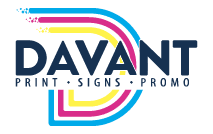Printing your marketing materials takes some time and thought. First, there’s the design phase where your marketing team has spent tireless hours obsessing over every detail and word, making sure it’s the right fit for the campaign. Then comes the printing. Many companies outsource their marketing printing because of the large volume they need to produce, and they don’t want to bog down the communal office printer.
Printing a variety of marketing materials is something Davant offers, and we help guide our clients through the array of options, including paper quality, colors, and whether or not they want to go with offset printing or digital printing. For many, these last two terms mean nothing, and they want the best quality for their project. But in reality, knowing the distinction between these two methods of printing can make all the difference and determine whether or not your project comes within budget.
What is Offset Printing?
Offset printing has been around since the 18th century and has been used on a large scale to print newspapers, magazines, booklets, advertisements, and more. This method works by transferring ink from a metal—usually aluminum—plate onto a rubber sheet, which then presses onto the final printing paper or material. Offset printing is often the preferred method for those looking to print larger sheets of paper. The finished product is professional, crisp, and clean.
What is Digital Printing?
Digital printing, on the other hand, does not use metal plates and rubber sheets to transfer images and words onto the paper or vinyl. Instead, digital printers use electrostatic rollers—or drums—to apply the right amount of toner onto a piece of paper, business card, or whatever you need to print. Once the toner is applied to the sheet, it’s then fused to the material by passing through a high-heat unit in the printing machine before being produced on the other side.
Which One is Better?
The short answer is: It just depends.
There are a couple of things to keep in mind when it comes to printing and deciding between your method choices. The first is quantity, and the second is price. Both of these go hand-in-hand when it comes to printing.
With offset printing, a new plate and rubber mat have to be created for each project, which means you’ll likely find that you have to pay an upfront fee to get the job started. Because each project is unique, offset printing is better for projects that need more than 1,000 copies. Businesses that print in volume and don’t need to make constant changes to their content find that offset printing is the best option, both from a quality standpoint and a financial one. In offset printing, most companies learn that their upfront fee is quickly absorbed by the quantity of their order, making this method a no-brainer.
With digital printing, there is more flexibility, and it tends to be more cost-effective upfront. With a flat fee, you can pay for all of your copies upfront and make changes to your content whenever you want. For companies that are continually reprinting new material, digital printing makes sense. Digital printing is also the best for those last-minute projects that can come up and for smaller projects between 500 to 1,000 copies.
Still, advances in technology have made offset printing and digital printing competitive. In fact, digital printing products are often confused for offset printing, especially to those looking through untrained eyes. The choice is all up to the business and what they prefer.
Davant is Your One-Stop-Shop
Whether you’re looking for a last-minute print job or have a mailer campaign for all of Indianapolis, Davant has you covered. Our state-of-the-art offset and digital printing equipment provide you with a high-quality product on time and within your budget. Visit us at davantindy.com to learn more.
Photo Credit: https://www.pexels.com/photo/green-and-black-industrial-machine-1440504/

